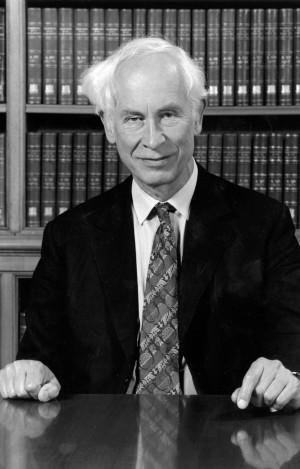Biologist who unravelled how animal behaviour develops.

Rarely a day goes by without extravagant claims being made about whether some human characteristic — be it intelligence, violence or sporting prowess — is explained by genes or environment, biology or upbringing, 'nature or nurture'. Patrick Bateson exposed the folly of such false dichotomies. In a 50-year career, he made seminal contributions to almost every topic in the science of animal behaviour, becoming a leading authority on behavioural development.
Bateson, born on 31 March 1938, decided at an early age to be a biologist. He was influenced by the legacy of his grandfather's famous cousin, the geneticist William Bateson, and by a keen interest in birdwatching. Bateson was educated at Westminster School in London before beginning an undergraduate degree in natural sciences at the University of Cambridge, UK, in 1957. In 1963, he married Dusha Matthews, with whom he had two daughters. Apart from a two-year fellowship working with neuroscientist Karl Pribram at Stanford University in California, Bateson spent his whole career at the University of Cambridge in the Sub-Department of Animal Behaviour.
Bateson's early research was influenced by two luminaries of ethology, Niko Tinbergen and Robert Hinde. Hinde supervised Bateson's PhD on behavioural imprinting — the tendency of young birds, such as goslings, to latch on to and follow the first moving stimulus they see, typically their mothers. At the time, the mechanisms underlying imprinting were a mystery and hotly disputed.
Bateson defused the contention through decades of pioneering experimentation into the underlying genetic, neural, physiological and experiential bases of the phenomenon, largely in collaboration with neuroscientists Gabriel Horn and Steven Rose. As psychologists had argued, imprinting is a form of perceptual learning, whereas, as ethologists had maintained, it involves an unlearned predisposition to attend to the physical characteristics of the mother.
Bateson also studied mate choice, animal welfare, play, learning and memory, and the role of behaviour in evolution. He had an eloquent writing style and published influential books. These included Measuring Behaviour (Cambridge University Press, 1986), an introduction to the methodology of the field co-authored with ethologist Paul Martin, and Design for a Life: How Behaviour Develops (Jonathan Cape, 1999), also written with Martin. Some of the volumes edited or co-edited by Bateson, notably Growing Points in Ethology in 1976 and Mate Choice in 1983 (both Cambridge University Press), shaped thinking in these fields. He edited the influential Perspectives in Ethology series for 20 years, and for 5 years was editor of Animal Behaviour, the leading journal in ethology.
Bateson held exalted positions in British science, including provost of King's College at the University of Cambridge (1988–2003), president of the Zoological Society of London (2004–14) and biological secretary and vice-president of the Royal Society (1998–2003). He proved a leader in other ways too, showing courage, integrity and sensitivity in tackling emotive topics, including dog breeding and the use of animals in medical research. Bateson was also commissioned by the National Trust, a UK conservation and heritage charity, to lead a review into the physiological effects of hunting in deer, which resulted in the trust banning the practice on its land.
Bateson was adept at helping others to develop a more nuanced understanding of tricky issues, such as overly simplistic adaptationism at a time when 'gene for X' language was rife. His calm and reasoned writings ensured that the whole organism and a systems perspective remained in sight during the heyday of genetic determinism.
Bateson maintained a keen interest in evolutionary biology, but envisaged a broader conception of evolutionary causation, one that eschewed gene-centricism and placed the organism centre stage. This led some biologists to view him as a maverick. Nonetheless, Bateson was ahead of the curve in recognizing the evolutionary significance of mate choice, sympatric speciation (when populations of a species in one habitat become reproductively isolated from each other) and developmental plasticity, which have since become mainstream concepts.
He also recognized the importance of ideas such as epigenetic inheritance and niche construction, which are now garnering increased attention. Behind the scenes, by organizing conferences and workshops and by promoting the work of progressive thinkers, Bateson helped to incubate ideas that are central to the emerging extended evolutionary synthesis.
An approachable and affectionate scientist, he insisted on being called Pat by everyone. He was open-minded, a good listener and curious about science. Bateson was dedicated to his students and collaborators, and made time for anyone who wanted to discuss their research. He was a loyal colleague, mentor and friend. Pat and Dusha were excellent hosts in their lodge at King's College. They would warmly welcome all guests, whether graduate students or international dignitaries, introducing them to their collection of cats.
Patrick Bateson died on 1 August, aged 79. His death marks the end of a glorious era of behavioural research. His legacy will long be appreciated.
Author information
Authors and Affiliations
Corresponding author
Related links
Rights and permissions
About this article
Cite this article
Laland, K. Patrick Bateson (1938–2017). Nature 548, 394 (2017). https://doi.org/10.1038/548394a
Published:
Issue Date:
DOI: https://doi.org/10.1038/548394a
